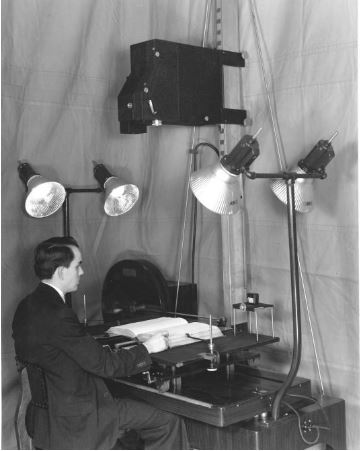Materials created and produced by United States federal agencies, or by an officer or employee of the United States Government as part of that person's official duties, are considered works of the United States Government. These works are not eligible for copyright protection, in the United States, and are treated as though they are in the public domain. However, not all records in the holdings of the National Archives and Records Administration (NARA) are in the public domain – especially NARA’s Special Media holdings. Some records may contain, in whole or in part, material which is restricted by federal copyright law, state common law or state statutes that protect intellectual property, contract law, deed restrictions, or publicity rights in the United States or in other countries.
The Copyright Law of the United States (Title 17, United States Code) governs the making of photocopies or other reproductions of copyrighted material. This law provides that under certain conditions, libraries and archives are authorized to furnish reproductions of materials, allowing that the reproduction is not to be "used for any purpose other than private study, scholarship, or research." Commercial or other uses without permission, beyond what may be considered in excess of "fair use” exemptions under Title 17 of the Copyright Law, may make the user liable for copyright infringement.
Where obvious copyright or donor imposed restrictions apply, written permission from the rights holders may be required before NARA approves a reproduction request. Where the status of an item that is part of NARA’s holdings is unknown or cannot be determined, NARA will generally make it available for reproduction with a warning to the user that the responsibility for the subsequent use of the materials lies solely with the end user per NARA regulations at 36 C.F.R. 1254.62. This responsibility includes determining, for each of the items provided, whether all or part of the work has been copyrighted, and whether that protection has lapsed. This responsibility also includes determining whether any performance-based or other rights are claimed in the items provided.
NARA does not confirm copyright status for any items, indemnify the user from legal or other action, or provide a definitive statement of public domain status, copyright, or other intellectual property or proprietary rights. Further, NARA does not license its content, or grant exclusive or non-exclusive publication privileges or usage rights to records. NARA can provide users with any information that was acquired with the material, such as accession files, agency catalogs, scripts and production files, and deed of gift agreements.
NARA reserves the right to refuse to fill any reproduction request if, in NARA’s judgment, fulfillment of the order might violate copyright law, or is not accompanied by permission from the copyright holder or collection donor. NARA maintains a Source and Permissions Contact List for some motion pictures, sound and video sources.
NARA recommends that researchers contact the United States Copyright Office at The Library of Congress to search currently copyrighted materials, or seek guidance of legal or rights and clearances specialists. For more information about copyright law in the United States, please visit the United States Copyright Office.
For more information and exceptions to Copyright in US Government works

